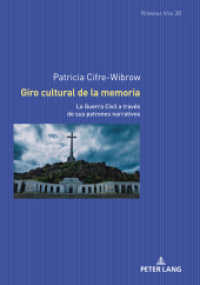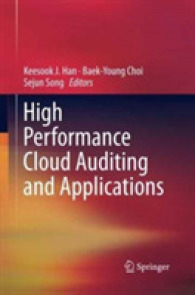- ホーム
- > 洋書
- > 英文書
- > Science / Mathematics
Full Description
The book comprehensively reviews the significant researches in silk during the millennium. Silk known as the queen of textiles is a fibre, has unique properties which have been well explored and exploited for varied applications. The primary objective of writing this book is to create an awareness of the researches in the area and stimulate the readers to explore more about the fibre. It would be very useful to students for carrying out their project work, scholars and researchers in carrying out research in such an interesting area. The topics discussed herein are varied and cover a broad range like application of natural dyes on silk, study of specific properties which have not been explored earlier, etc. Propreties of silk blends have been discussed. Different varieties of silk have been explored which include some non mulberry silk varieties and also spider silk. It is hoped that the book would provide useful reading and promote further research in the area. It is deemed a privilege to duly acknowledge the researchers whose noteworthy contributions have been included in the book. Suggestions are invited to further enhance the quality of the book.
Contents
Preface1 Copolymerization method of weighing silk2 Modification of silk fibre properties by graft copolymerization3 Silk dyeing with natural mordant4 Effect of cooking and other treatments on the quality of raw silk5 Factors influencing quality and reeling performance of multi-bivoltine raw silk cocoons6 Crystallite-shape ellipsoid of non-mulberry silk7 Measurement of cohesion is silk yarn8 Relating the microstructure and microrheological factors of different silk fibres9 New method of evaluation of low-stress mechanical properties of silk fabrics10 Kinetics of adsorption of natural dye on silk: Effect of surface modification11 Woven mulberry silk fabrics: Stretch and growth characteristics12 Enhancement of coloration and antimicrobial properties of silk fabrics through nanotechnology13 Influence of electric field on bivoltine mulberry and tasar fibres14 Torsional rigidity of mulberry and non-mulberry silks15 A qualitative and quantitative comparison of sericin from various sources16 Optimization of technological parameters for steeping silk on small reels17 Drying of silk in re-reeling process by infrared technique18 Dyeing of silk with bio ecological mordant19 Influence of laundering and water temperature on the properties of silk and silk-blended knits20 Physical and thermal properties of grafted silk fabrics21 Anti-wrinkle properties of silk fabrics dyed with reactive and crosslinking dyes22 Polyester/waste silk core spun yarns and fabrics23 Relation between cocoon parameters and raw silk uniformity characteristics24 Technical aspects of spider silk and applications25 Morphology studies on electrospun nano silk fibre26 Technical aspects of silk sericin27 Application of genetic algorithm for design of silk scaffolds28 Special technique for the investigation of crystal and molecular structure of muga wild silk29 Development of silk fabric patterns through new eco-printing method30 Effect of some key factors on scouring of sericin in muga silk cocoonsIndex








